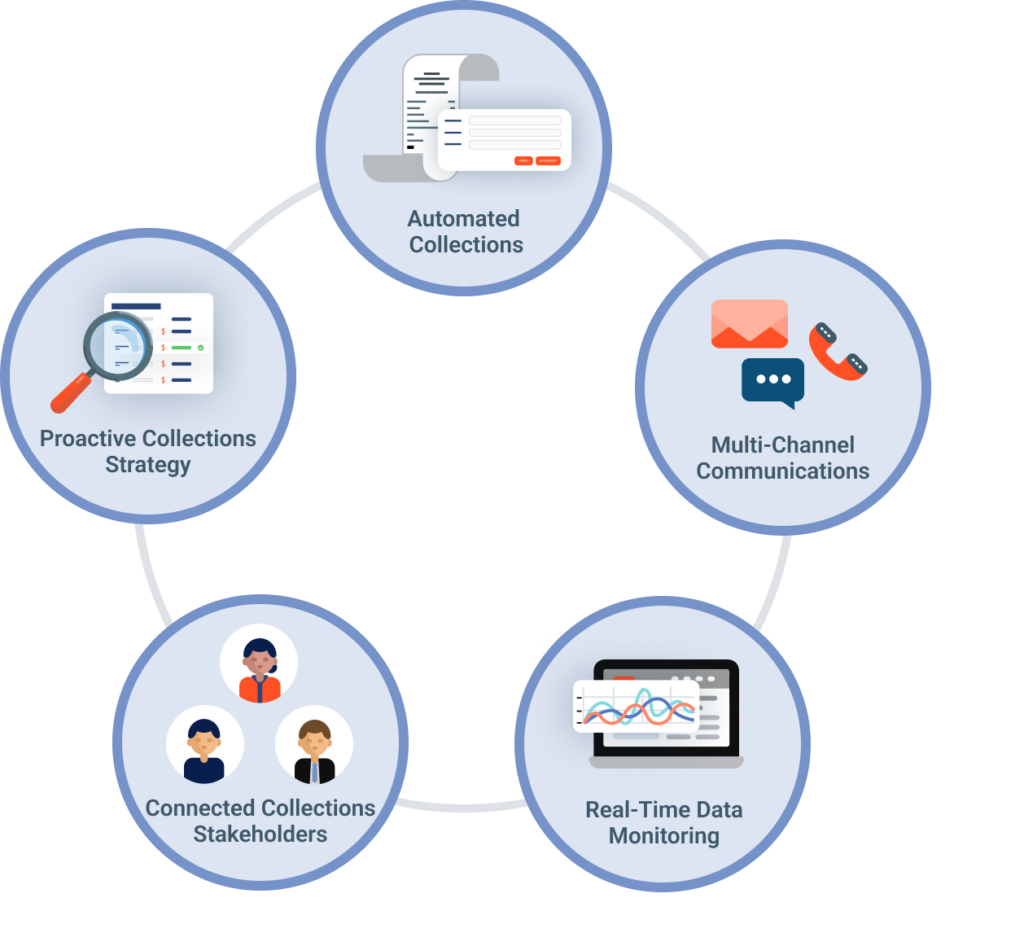Is your debt collection strategy working for you?
In this article, you will discover five debt collection best practices tailored for SMEs. If you’ve not yet implemented these strategies, you’re missing out on recoverable debt.
Debt collection can be a time-consuming and labor-intensive process that is unpleasant for both the lender and the borrower. However, it arises naturally in the SME lending lifecycle, as borrowers struggle to pay for several reasons. The key is to balance the interests of both parties.
As a lender, you need to limit losses and collect past-due debts. On the other hand, your borrowers must avoid unnecessary credit deterioration by paying off as much as possible in a reasonable time frame.
A holistic approach to debt collection can help you more effectively manage your collection efforts as you limit losses and keep your borrower’s best interests in mind.
Why It’s Necessary to Take a Holistic Approach to Collections

Borrowers that interact with lenders via traditional collection techniques experience a cold collection process.
These techniques fail to account for individual borrower circumstances. Instead, they send impersonal, often unhelpful payment reminder messages, and require borrowers to pay via limited methods and time frames. In short, they make the process inefficient and inconvenient for the borrower.
By prioritizing customer service in the collections process, you can improve your business’s reputation, increase customer retention, and save your business time and resources. A holistic approach to debt collection puts the borrower at the center of the collection strategy, and ultimately benefits all parties involved.
By adapting your communication style and choosing the right channels to interact with each individual borrower, the relationship becomes more responsive and your lending process more agile. Together, you can work better to recover debt and adjust payment terms favorably.
If you want to reap the benefits of a holistic collections approach for your SME lending business, follow these five debt collection best practices.
1. Automate Your Collections
Debt collection involves repetitive, clerical actions that, although simple to execute, come in huge volumes. If you don’t have automated systems to help you, it becomes a real hassle.
If you’re using outdated systems or paper-based processes, there is little room for automation and even personalization.
If this sounds like you, consider implementing a modern lending software that allows you to automate as much of the lending process as possible. Not quite sure what a modern lending software looks like? Check out our recent article on the topic to learn how to choose the best lending software for your business.
2. Use Multi-Channel Communications With Your Clients
Even though your borrowers owe you money, they are still your customers! With many small businesses navigating unprecedented uncertainty, the age-old saying “customer is king” applies more than ever before.
With SMS, email, social media, and a growing number of communication channels available, you need to know which communication channel each of your clients prefers. By letting them choose whichever medium they use most, you give them control over how they interact with you.
Just because multiple channels are available, it doesn’t mean that you should communicate through all of them. It would be time-consuming, expensive, and could do you more harm than good—over-communication can lead to poor client experiences.
Instead, give your customers more control over communications and clear messaging. A digital-first strategy that meets your borrowers where they actually are will improve satisfaction and increase the likelihood of them not missing payment reminders.
Recent McKinsey research highlights the utility of this type of strategy, stating:
“When contacted digitally, they [borrowers] are more likely to make a payment or to pay in full, and this likelihood increases for customers with accounts that are more than 30 days past due.”
3. Monitor Data in Real-Time
You may already be monitoring loan performance at weekly or monthly intervals, but that’s not good enough—you need more if you want an agile collections process.
By using modern digital lending management software that supports real-time monitoring, you are always aware of your borrowers’ financial health. A centralized “one-source-of-truth” data repository will automatically integrate data from a variety of sources. Having all of your data in a single location means it can be easily accessed, analyzed, and visualized.
This allows you to detect credit deterioration early, take precautions before anything gets bad, and help your clients stay on track with payments as you predict the best possible time to collect based on a customer’s payment history.
Want to learn more about data reporting for SME and alternative lenders? Check out our recent blog on the topic.
4. Keep Your Collections Stakeholders Connected
If you want collections to be truly efficient, you must keep all your collections stakeholders connected, not just your clients. Keeping all parties involved and informed ensures that they can act on the correct information at the right time.
If you’re using a collections agency to recover debt, you need to keep them well-informed about payment statuses and, if possible, provide real-time information so that they do not chase clients repeatedly.
If you’re curating loans with syndicators, keeping them apprised with the latest updates regarding the quality of the loan and payments made to their accounts is essential. Remember, today, it is not uncommon to have multiple syndicators (up to 15!) participating in a single loan.
With Onyx IQ, you can keep in touch with your borrowers, brokers, and loan syndicators on one platform.
5. Adopt a Proactive Collections Strategy
A proactive collections strategy begins before delinquency and will incorporate all essential pillars of your lending strategy: forecasting, risk classification, innovative technology, and effective communication.
Crucially, understanding an applicant’s ability to repay a loan (and predicting any future deterioration in their financial health) is key. Here, technology that leverages predictive analytics in risk models to perform individual analyses can help make forecasting a simpler and more streamlined experience for you.
Equipped with the most accurate information from the beginning of the lending process, you can be better prepared for what may arise in a client’s future. After all, the best collection strategy is not having to resort to collections at all.
Streamline Soft Collections With Onyx IQ
While unpaid invoices are a common occurrence across industries, SME lenders and businesses are often hit the hardest. They operate on small margins and have limited resources for debt recovery. Adopting the practices discussed in this article is crucial to running a profitable lending business.
With a modern saas lending platform like Onyx IQ, you can make your soft collections simple and repeatable. You’ll have access to collections templates and unlimited third-party communications to send requests to collections stakeholders. With intelligent collections workflows that eliminate repetitive tasks, you can also reduce your collections personnel by up to 30%!
Check out the Onyx IQ website to learn more about our lending platform, or contact us at info@onyxiq.com.
If you’d like to give it a try, schedule your Onyx IQ demo today.

